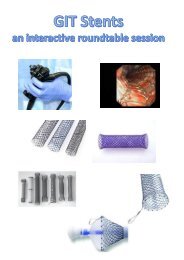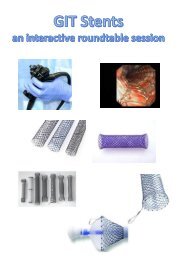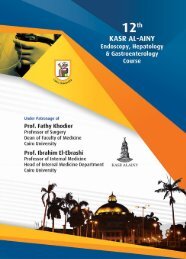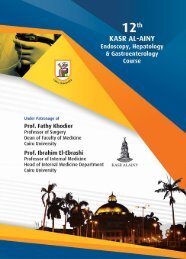Where are we on the path to eliminate hepatitis C virus ?
You also want an ePaper? Increase the reach of your titles
YUMPU automatically turns print PDFs into web optimized ePapers that Google loves.
Are <str<strong>on</strong>g>we</str<strong>on</strong>g> <strong>on</strong> <strong>the</strong> <strong>path</strong> <strong>to</strong> <strong>eliminate</strong><br />
<strong>hepatitis</strong> C <strong>virus</strong> ?<br />
M<strong>on</strong>a Amin<br />
Professor of internal medicine<br />
Hepa<strong>to</strong>-gastroenterology<br />
Cairo University<br />
1
The Life cycle of an Infectious Disease<br />
1. Discovery √<br />
2. Reliable Diagnostic Test √<br />
3. Effective Therapy √<br />
4. Protective Vaccinati<strong>on</strong><br />
5. C<strong>on</strong>trol Of Disease Burden<br />
6. Eliminati<strong>on</strong> Of Infecti<strong>on</strong><br />
7. Global Eradicati<strong>on</strong> Of Infecti<strong>on</strong><br />
2
C<strong>on</strong>trol vs. Eliminati<strong>on</strong> vs. Eradicati<strong>on</strong><br />
‣C<strong>on</strong>trol: Reducti<strong>on</strong> In Prevalence,<br />
Morbidity/Mortality Of An Infectious Disease To A<br />
Locally Acceptable Level.<br />
‣Eliminati<strong>on</strong>: Reducti<strong>on</strong> To Zero Of The<br />
Incidence Of Disease Or Infecti<strong>on</strong> In A Defined<br />
Geographical Area, But Requires C<strong>on</strong>tinued<br />
Measures To Prevent Re-establishment Of<br />
Transmissi<strong>on</strong><br />
‣Eradicati<strong>on</strong>: Permanent Reducti<strong>on</strong> To Zero Of<br />
The Worldwide Incidence Of Infecti<strong>on</strong>, With No<br />
Fur<strong>the</strong>r C<strong>on</strong>trol Measures Required WHO 1998<br />
CDC, 1993; Dowdle, 1998.<br />
3
• World Health Organizati<strong>on</strong> goal is <strong>to</strong> <strong>eliminate</strong><br />
<strong>hepatitis</strong> C <strong>virus</strong> (HCV) as a public health threat<br />
• Specifically, <strong>the</strong> goal is dramatic and large scale<br />
reducti<strong>on</strong>s in new transmissi<strong>on</strong>s of HCV, as <str<strong>on</strong>g>we</str<strong>on</strong>g>ll<br />
as in <strong>the</strong> number of people becoming ill and<br />
dying from HCV, <strong>to</strong> a level where HCV no l<strong>on</strong>ger<br />
represents a major health c<strong>on</strong>cern<br />
• In numeric terms, <strong>the</strong> WHO has proposed<br />
reducti<strong>on</strong>s of 60% in HCV related mortality and<br />
90% in HCV transmissi<strong>on</strong> globally and in<br />
member countries<br />
John W. Ward, Gastroenterology & Hepa<strong>to</strong>logy 2016<br />
4
Why HCV Is A Tractable Target For<br />
Eradicati<strong>on</strong> ?<br />
• No known n<strong>on</strong>-human reservoir<br />
• There is no latent cellular reservoir<br />
• Pharmacologic treatment with direct<br />
acting antivirals can truly cure an<br />
infected pers<strong>on</strong>, treatment-based<br />
eliminati<strong>on</strong> is an opti<strong>on</strong><br />
5
Barriers To Eliminati<strong>on</strong><br />
• Hepatitis C is generally asymp<strong>to</strong>matic both during <strong>the</strong> acute<br />
and chr<strong>on</strong>ic phase.<br />
• Heavy c<strong>on</strong>centrati<strong>on</strong> of HCV infecti<strong>on</strong>s in difficult-<strong>to</strong> reach<br />
populati<strong>on</strong>s, including people who inject drugs and <strong>the</strong><br />
homeless, as <str<strong>on</strong>g>we</str<strong>on</strong>g>ll as marginalized groups such as <strong>the</strong><br />
incarcerated.<br />
• The treatment cost is expensive. This expense raises<br />
c<strong>on</strong>cerns about <strong>the</strong> feasibility of widespread treatment<br />
• A prophylactic vaccine may be an essential missing piece of<br />
<strong>the</strong> effort <strong>to</strong> <strong>eliminate</strong> <strong>hepatitis</strong> C.<br />
• Reinfecti<strong>on</strong> is a possibility<br />
6
Nearly Every<strong>on</strong>e With HCV Can Now Be Treated<br />
Successfully<br />
• Very high SVR rates; <strong>the</strong>rapies highly <strong>to</strong>lerable<br />
• All-oral <strong>the</strong>rapy for almost every pt<br />
• Treatment generally just 12 wks<br />
100<br />
80<br />
60<br />
40<br />
Standard<br />
Interfer<strong>on</strong><br />
1991<br />
Ribavirin<br />
1998<br />
34<br />
Peginterfer<strong>on</strong><br />
2001<br />
42 39<br />
55<br />
Direct-Acting<br />
Antivirals<br />
2011<br />
70+<br />
2013<br />
90+<br />
All-Oral<br />
Therapy<br />
Current<br />
95+<br />
20<br />
0<br />
6<br />
IFN<br />
6 Mos<br />
16<br />
IFN<br />
12 Mos<br />
IFN/RBV<br />
6 Mos<br />
IFN/RBV<br />
12 Mos<br />
PegIFN<br />
12 Mos<br />
PegIFN/<br />
RBV<br />
12 Mos<br />
PegIFN/<br />
RBV +<br />
DAA<br />
DAA +<br />
RBV ±<br />
PegIFN<br />
All–Oral<br />
DAA±<br />
RBV<br />
7
We Now Have <strong>the</strong> Tools . . . What Do<br />
We Do With Them?<br />
‣Should We Focus Primarily On Pts With<br />
Cirrhosis?<br />
‣Should We Try To Cure Every<strong>on</strong>e?<br />
8
9
10
Viremic Infecti<strong>on</strong>s (by Stage)<br />
Impact of HCV: What Happens If We Do<br />
Nothing?<br />
• Change in <strong>the</strong> number of HCV-related liver transplants,<br />
decompensated cirrhosis cases, and HCC cases over time<br />
HCC<br />
Decompensated cirrhosis<br />
Liver transplant<br />
England<br />
Yr<br />
S<str<strong>on</strong>g>we</str<strong>on</strong>g>den<br />
3500<br />
1000<br />
900<br />
3000<br />
800<br />
2500<br />
700<br />
600<br />
2000<br />
500<br />
1500<br />
400<br />
1000<br />
300<br />
200<br />
500<br />
100<br />
0<br />
0<br />
1950 1960 1970 1980 1990 2000 2010 2020 2030 1950 1960 1970 1980 1990 2000 2010 2020 2030<br />
Yr<br />
Razavi H, et al. J Viral Hepat. 2014;21(suppl 1):34-59.<br />
11
Deaths (n)<br />
Focusing <strong>on</strong> Pts With Cirrhosis:<br />
The English Experience<br />
• Deaths caused by end-stage liver disease or HCC in pts with HCV<br />
menti<strong>on</strong>ed <strong>on</strong> death certificate: UK 2005-2015<br />
500<br />
450<br />
400<br />
350<br />
300<br />
250<br />
200<br />
150<br />
100<br />
50<br />
0<br />
2005 2006 2007 2008 2009 2010 2011 2012 2013 2014 2015*<br />
Yr<br />
*2015 data provisi<strong>on</strong>al for England/Wales, missing for Nor<strong>the</strong>rn Ireland.<br />
Office for Nati<strong>on</strong>al Statistics for England and Wales; Deaths registrati<strong>on</strong><br />
data supplied by NISRA for Nor<strong>the</strong>rn Ireland; Health Protecti<strong>on</strong> Scotland<br />
in associati<strong>on</strong> with Informati<strong>on</strong> Services Divisi<strong>on</strong>.<br />
12
Focusing <strong>on</strong> Cirrhosis<br />
Rapid reducti<strong>on</strong> in mortality<br />
But<br />
– Means forever playing “catch up”<br />
– People with cirrhosis remain at risk of<br />
HCC and must remain under<br />
surveillance—<strong>the</strong>y <str<strong>on</strong>g>are</str<strong>on</strong>g> <strong>the</strong> most<br />
expensive <strong>to</strong> treat<br />
Slide credit:<br />
13
Can We Do More?<br />
Should <str<strong>on</strong>g>we</str<strong>on</strong>g> try <strong>to</strong> find and treat<br />
every<strong>on</strong>e with HCV infecti<strong>on</strong>?<br />
14
Pts (%)<br />
HCV in <strong>the</strong> US: Gaps in Current Practice<br />
100<br />
100%<br />
80<br />
60<br />
50%<br />
43%<br />
40<br />
27%<br />
20<br />
17% 16%<br />
9%<br />
0<br />
Chr<strong>on</strong>ic<br />
HCV<br />
Infected<br />
Diagnosed<br />
and<br />
Aw<str<strong>on</strong>g>are</str<strong>on</strong>g><br />
Access<br />
<strong>to</strong><br />
C<str<strong>on</strong>g>are</str<strong>on</strong>g><br />
HCV RNA<br />
C<strong>on</strong>firmed<br />
Liver<br />
Biopsy<br />
Prescribed<br />
HCV<br />
Treatment<br />
Achieved<br />
SVR<br />
n = 3,500,000 1,743,000 1,514,667 952,726 581,632 555,883 326,859<br />
Yehia BR, et al. PLoS One. 2014;9:e101554.<br />
15
16
HCV is not JUST a liver <strong>virus</strong><br />
‣People with HCV infecti<strong>on</strong> <str<strong>on</strong>g>are</str<strong>on</strong>g><br />
not just “livers <strong>on</strong> legs”<br />
‣People with HCV infecti<strong>on</strong> have<br />
MANY health c<strong>on</strong>cerns<br />
17
Change in Summary PRO<br />
Score From BL <strong>to</strong> EOT<br />
(scale: 0-100)*<br />
Pt-Reported Outcomes Improve With DAA<br />
Therapy<br />
• End-of-treatment changes from baseline in summary pt-reported outcomes<br />
am<strong>on</strong>g 818 pts treated with SOF/VEL or SOF + RBV in ASTRAL-2 (GT2) and<br />
ASTRAL-3 (GT3)<br />
10<br />
8<br />
6<br />
4<br />
2<br />
0<br />
-2<br />
-4<br />
-6<br />
-8<br />
P = .16<br />
SF-36:<br />
Physical<br />
Comp<strong>on</strong>ent<br />
Summary<br />
SOF + RBV<br />
P = .0001<br />
SF-36:<br />
Mental<br />
Comp<strong>on</strong>ent<br />
Summary<br />
SOF/VEL<br />
P = .0001 P = .0009<br />
FACIT-F:<br />
Fatigue<br />
FACIT-F:<br />
Total<br />
P = .0012<br />
CLDQ-<br />
HCV:<br />
Total<br />
P = .0024<br />
WPAI:SHP:<br />
Work<br />
Productivity<br />
P = .0002<br />
WPAI:SHP:<br />
Activity<br />
*Changes of > 2 points represent significant difference from BL within treatment group (P < .05).<br />
Younossi ZM, et al. Clin Infect Dis. 2016;63:1042-1048.<br />
18
Pts (%)<br />
HCV Affects Pts’ Lives Now: Indirect<br />
Ec<strong>on</strong>omic Costs of HCV<br />
• 2010 EU Nati<strong>on</strong>al Health and Wellness Survey: HCV associated with<br />
significantly lo<str<strong>on</strong>g>we</str<strong>on</strong>g>r scores vs c<strong>on</strong>trols in several HRQoL domains (P < .05) [1]<br />
• 2009 US Nati<strong>on</strong>al Health and Wellness Survey: pts with HCV significantly less<br />
likely <strong>to</strong> be employed vs c<strong>on</strong>trols (P < .0001) [2]<br />
30<br />
20<br />
Pts with HCV<br />
C<strong>on</strong>trols<br />
17<br />
14<br />
19<br />
15<br />
25<br />
22<br />
10<br />
5<br />
3<br />
0<br />
Absenteeism Presenteeism Overall Work<br />
Impairment<br />
Activity<br />
Impairment<br />
1. DiB<strong>on</strong>aventura Md, et al. Eur J Gastroenterol Hepa<strong>to</strong>l. 2012;24:869-<br />
877. 2. DiB<strong>on</strong>aventura Md, et al. J Med Ec<strong>on</strong>. 2011;14:253-261.<br />
19
In Every Country Analyzed, Treatment Is More Cost Saving<br />
Estes C, Abdel-K<str<strong>on</strong>g>are</str<strong>on</strong>g>em M, Abdel-Razek W, Abdel-Sameea E, Abuzeid M, Gomaa A, et al. Ec<strong>on</strong>omic burden of <strong>hepatitis</strong> C in<br />
Egypt: <strong>the</strong> future impact of highly effective <strong>the</strong>rapies. Aliment Pharmacol Ther 2015 Jul 22.<br />
20
Treating Every<strong>on</strong>e<br />
‣Encourages testing<br />
‣Improves quality of life<br />
‣Reduces <strong>on</strong>ward transmissi<strong>on</strong><br />
21
Increasing SVR >90% without change in numbers treated<br />
has small impact <strong>on</strong> morbidity & mortality -<br />
22
Increasing SVR >90% with increase in numbers<br />
treated 5-fold out could <strong>eliminate</strong> HCV by 2030<br />
23
Global Call for HCV Eliminati<strong>on</strong><br />
• Visi<strong>on</strong>: “A world where viral <strong>hepatitis</strong> transmissi<strong>on</strong> is s<strong>to</strong>pped<br />
and every<strong>on</strong>e has access <strong>to</strong> safe, affordable, and effective<br />
treatment and c<str<strong>on</strong>g>are</str<strong>on</strong>g>”<br />
– 2020 target: 3 milli<strong>on</strong> HCV infecti<strong>on</strong>s treated<br />
• Feasible by scaling up 6 key interventi<strong>on</strong>s <strong>to</strong> high coverage:<br />
– Hepatitis B vaccinati<strong>on</strong> (including birth dose)<br />
– Safe injecti<strong>on</strong> practices and safe blood<br />
– Harm reducti<strong>on</strong> for injecting drug users<br />
– Safer sex (including c<strong>on</strong>dom promoti<strong>on</strong>)<br />
– Hepatitis B treatment<br />
– Hepatitis C cure<br />
2030 Targets<br />
90% Diagnosed<br />
WHO. Towards <strong>the</strong> eliminati<strong>on</strong> of <strong>hepatitis</strong> B and C by 2030.<br />
Draft WHO Global Hepatitis Strategy, 2016-2021.<br />
80% Treated<br />
65% Reduced Mortality<br />
24
Eliminating HCV Is Every<strong>on</strong>e’s Job<br />
• Identify undiagnosed HCV<br />
– HCV rapid testing<br />
– Opiate replacement<br />
<strong>the</strong>rapy<br />
– Syringe access<br />
• Preventing infecti<strong>on</strong> and<br />
reinfecti<strong>on</strong><br />
– Outreach and educati<strong>on</strong><br />
– Safer injecti<strong>on</strong> counseling<br />
– Reinfecti<strong>on</strong> preventi<strong>on</strong><br />
counseling<br />
• Treatment access and<br />
delivery<br />
– Linkage <strong>to</strong> HCV c<str<strong>on</strong>g>are</str<strong>on</strong>g><br />
– Access <strong>to</strong> HCV drugs<br />
– Primary c<str<strong>on</strong>g>are</str<strong>on</strong>g>–based<br />
<strong>the</strong>rapy<br />
– Methad<strong>on</strong>e-based directly<br />
observed <strong>the</strong>rapy<br />
– Access <strong>to</strong> specialty c<str<strong>on</strong>g>are</str<strong>on</strong>g><br />
25
What Would It Take For Global Eliminati<strong>on</strong> Of HCV?<br />
World Health Organisati<strong>on</strong> Targets For 2030<br />
26
WHAT needs <strong>to</strong> be d<strong>on</strong>e?<br />
1<br />
• Innovative treatment <strong>to</strong> be<br />
affordable<br />
2<br />
• Diagnosis rate <strong>to</strong> be<br />
efficient and effective<br />
3<br />
• Strategies <strong>to</strong> avoid infecti<strong>on</strong><br />
and reinfecti<strong>on</strong><br />
27
The Key Fac<strong>to</strong>r Of A Successful Strategy:<br />
28
29
Member States with Nati<strong>on</strong>al Viral Hepatitis Plans<br />
2016 (NVHP) (n=36)<br />
30
Could HCV Be Eliminated Through Antiviral Therapy?<br />
DAA Therapies Combined With Increased Uptake<br />
31
WHO May 2016<br />
32
Impact Of Preventi<strong>on</strong> On Outcome Of Scenario .<br />
33
HCV C<strong>on</strong>trol <strong>to</strong> Eliminati<strong>on</strong> (90/90/90)<br />
34
35
Take Home Points<br />
‣Treatment in 2016 is effective, becoming<br />
simplified, and provides all-oral opti<strong>on</strong>s for<br />
almost every pt<br />
– Next generati<strong>on</strong> of <strong>the</strong>rapy expected <strong>to</strong> be<br />
pangenotypic, effective for previous DAA failure<br />
‣Goals in HCV <strong>the</strong>rapy expanding bey<strong>on</strong>d<br />
individual cure <strong>to</strong> HCV eliminati<strong>on</strong>; keys<br />
include:<br />
– Involving primary c<str<strong>on</strong>g>are</str<strong>on</strong>g><br />
– Addressing barriers <strong>to</strong> treatment<br />
– Providing effective <strong>the</strong>rapy <strong>to</strong> challenging pt groups<br />
36
37

















